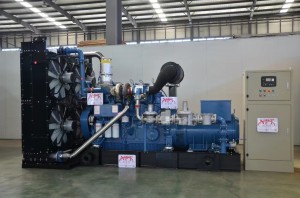Gas generator sets have a wide range of applications, and their operating modes vary and are flexible and diverse in different application scenarios.
1. Grid connection mode
Grid connected mode is currently the most commonly used operating mode for units, which can be divided into two types: grid connected and non grid connected.
(1) Connected to the grid
One or more gas generator units operate in parallel with the public power grid at the user end to transmit electricity to the public power grid. In this mode, the load of the gas generator set is the power grid, and the power of the generator set is determined by the set value. The maximum power set is the maximum power generated.
It has a wide range of application scenarios, including industrial gas, gas, biomass gas, natural gas, and other power generation applications, and can generate profits by selling electricity.
(2) Grid connected but not connected
One or more gas generator units operate in parallel with the public power grid at the user end, but do not transmit electricity to the public power grid. That is to say, the electricity generated by the power station is only for self consumption and some loads need to be supplemented by the power grid. This form is often used in natural gas cogeneration supply scenarios.
2. Island mode
Island operation is a way in which the unit operates completely independent of the public power grid. In island operation mode, it can be divided into single machine island operation and multi machine island operation. This type of mode is suitable for remote areas without mains power supply, such as oil wells, deserts, etc.
(1) Single machine island
A single gas generator unit supplies power to some isolated loads, with the characteristic that the power of the generator unit is determined by the load, and the power of the load is the power of the generator unit. For example, if a person carries a burden and the burden is heavy, they will exert as much force as possible.
(2) Multi machine island
After multiple gas generator units are combined, they supply power to some isolated loads. Slightly more complex than single machine island mode, the active and reactive power of each unit is managed uniformly by the system. The system allocates the active and reactive power output of a single unit according to the preset proportion based on the real-time electricity demand of users.
3. Grid connection without grid connection (load following) and islanding mode switching
This is a relatively complex operating mode suitable for areas with unstable power supply and occasional power outages. When the power grid is normal, the gas generator unit is connected to the grid for operation. Once the power grid malfunctions, it automatically switches to island operation to continuously ensure power supply.
Due to auxiliary equipment such as fans and water pumps, the gas generator set cannot be started after a power outage, but it can still continue to generate electricity despite a power outage during operation. In this system, the gas generator set, mains power, and load are on the same busbar. Through program control, the mains power always only provides a very small load, and the power of the generator set is slightly less than the load. When the mains power is cut off, the entire system immediately switches to island mode. At this time, although the mains power is cut off, the entire system can still work normally. After the mains power is restored, the control system can also adjust frequency and voltage again, connecting the system to the mains power again and restoring it to the grid connection state.
Post time: Nov-08-2023

